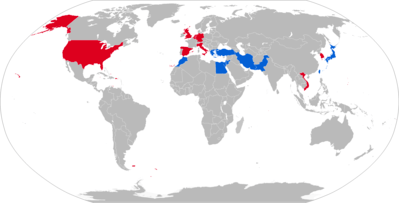M110 howitzer
| 8" M110 self-propelled howitzer | |
|---|---|
|
M110A2 of the Japan Ground Self-Defense Force in 2007 | |
| Type | Self-propelled artillery |
| Place of origin | United States |
| Service history | |
| Wars |
Vietnam War Iran–Iraq War 1982 Lebanon War Gulf War |
| Production history | |
| Manufacturer | General Motors Corp. (transmission)[1] |
| Specifications | |
| Weight | 28.3 metric tons (62,390 lb) |
| Length | 10.8 m (35 ft 5 in) |
| Width | 3.1 m (10 ft 2 in) |
| Height | 3.1 m (10 ft 2 in) |
| Crew | 13 (driver, 2 gunners, 2 loaders, (8 support crew–other vehicle)) |
|
| |
| Armor | 13 mm (.51 in) |
Main armament |
8" (203 mm) M201A1 howitzer 2 rounds |
Secondary armament | none |
| Engine |
Detroit Diesel 8V71T, 8-cylinder, 2-stroke, turbocharged diesel 405 hp (302 kW) |
| Suspension | Torsion bar |
Operational range | 523 km (325 mi) |
| Speed | 54.7 km/h (30 mph) |
The 8 inch (203 mm) M110 self-propelled howitzer was the largest available self-propelled howitzer in the United States Army's inventory. Consisting of an M115 203 mm howitzer installed on a purpose built chassis, it was deployed in division artillery in general support battalions and in separate corps- and army-level battalions. Missions include general support, counter-battery fire, and suppression of enemy air defense systems. The M110 was exported to a number of countries.
General characteristics
According to the operator's manual, the M110's typical rate of fire was three rounds per two minutes when operated at maximum speed, and one round per two minutes with sustained fire. The M110 featured a hydraulically operated rammer to automatically chamber the 200+ pound projectile. These rammers were prone to breakdown and generally slowed operation of the gun, because the rammers required crews to completely lower the massive barrel before using it. Highly trained and motivated U.S. Army crews could achieve two to four rounds per minute by using the hand-operated manual rammer, which was essentially a heavy steel pole with a hard rubber pad on one end. Using the manual rammer was physically demanding, but crews were not required to lower the barrels nearly as much as with the hydraulic rammer.
The M110's range varied from 16,800 meters to approximately 25,000 meters when firing standard projectiles, and up to 30,000 meters when firing rocket-assisted projectiles.
History
The M110A2 is the latest version with a double muzzle brake, the earlier A1 version had a plain muzzle. It first entered service with the U.S. Army in 1963. It was used in the Vietnam War by the United States Army, and in Operation Desert Shield and Operation Desert Storm by Romeo Battery 5th Battalion 10th Marines, and the British Army. The 2nd Battalion 18th Field Artillery and the 5th Battalion 18th Field Artillery served in Desert Storm with the M110A2 Howitzer, as well as the 142d Field Artillery Brigade (Arkansas Army National Guard). Most of the U.S. Army and USMC relied on the M109 series 155 millimeter gun systems during this conflict; sending remaining M110s to reserve or National Guard units. These units then took possession of M109s as they returned from service in the Gulf. M110s were still in service with the 3/92 FA (USAR) and running fire missions at Camp Atterbury as late as the summer of 1994.[2]
The gun system has been retired from U.S. Army service; howitzers above 155 mm caliber are no longer effective as technology has closed the range and firepower gap, and heavier weapon systems require more resources to operate. Gun barrels from retired M110s were initially used as the outer casing in the manufacture of the GBU-28 bunker buster bomb.
The M110A2s were made from refitted M110s or M107 175 mm SP guns (Hunnicutt).
At the end of the Cold War under U.S. Division Plan 86, all armored and mechanized infantry divisions included a battalion of heavy artillery that included two batteries of M110A2 8" SP howitzers with six guns each for a total of 12 guns, plus one battery of nine MLRS rocket artillery.
Projectiles
- M14 dummy
- M106 HE
- M650 HE rocket assist projectile (RAP)
- M509 ICM
- M404 ICM anti-personnel (airburst)
- M426 agent GB Sarin
- M422A1 W33 (nuclear weapon)
- M424 High Altitude Spotting Round for the M422 projectile
- W79 (nuclear artillery shell)
Operators

Current operators











Former operators

.svg.png)







See also
- List of U.S. military vehicles by model number
- 2S7 Pion – Soviet L/55.3 203 mm self-propelled cannon
- 2S4 Tyulpan – Soviet 240 mm self-propelled mortar
- List of crew served weapons of the US Armed Forces
- M107 – a 175 mm self-propelled gun on the same chassis
- Sholef – Israeli 155 mm self-propelled howitzer
- T92 Howitzer Motor Carriage – a 240 mm howitzer M1 fitted on a M26 Pershing chassis
References
- ↑ Defense Industry Bulletin, April 1968, p. 47.
- 1 2 UK M110 Artillery in action Gulf War 1991 https://www.youtube.com/watch?v=dJfcVG8mu_s
- ↑ "Deals in the Works". Federation of American Scientists. Retrieved 29 March 2011.
- ↑ John Pike. "Pakistan Army Equipment". Globalsecurity.org. Retrieved 2012-08-10.
- ↑ Stockholm International Peace Research Institute. "Transfers and licensed production of major conventional weapons". Retrieved 2011-12-10.
- ↑ Defense Security Cooperation Agency. "Excess Defense Articles". Archived from the original on 2012-01-14. Retrieved 2011-12-10.
- ↑ Pike, John. "Army Equipment - Taiwan". www.globalsecurity.org.
- TM 9-2350-304-10 dated October 1979
External links
| Wikimedia Commons has media related to M110 203 mm self-propelled howitzer. |
- Fas.org.
- Globalsecurity.org
- M110 Walk Arounds on Prime Portal
- Herzo Artillery Base in Germany www.herzobase.org